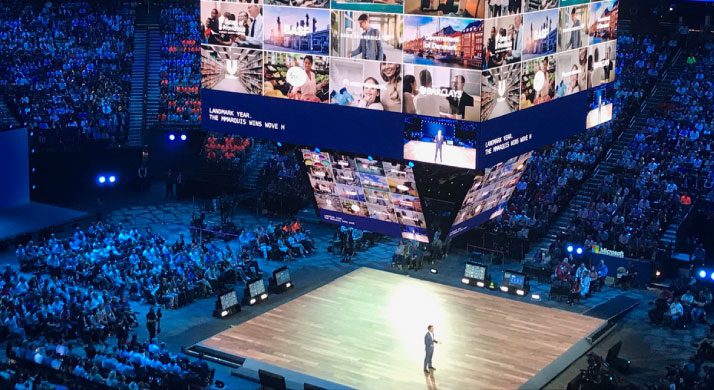Here’s how the new Edge signals a paradigm shift at Microsoft
A look at the biggest takeaways from Microsoft Build

Late spring is a key time for tech companies to show off new features in their respective portfolios, and to introduce projects that are coming down the pipeline for consumers and businesses to enjoy. Microsoft Build 2019 started out no different.
The event kicked off with a keynote from CEO Satya Nadella, who showcased some of the new features Windows 10, Azure, and Microsoft in general will be rolling out. There were demonstrations of different service applications by partner companies integrated with Azure and Microsoft services, as well as demonstrations featuring new and updated aspects to existing platforms.
Microsoft Build did more than just capitalize on the improvements made to existing platforms; it served as a launch pad for the newer paradigms Microsoft is utilizing to improve its products, inspire new users, and retain existing ones.
That being said, here is a look at the biggest takeaways from Microsoft Build 2019.
Integrating existing platforms into Azure has never been easier
One of Microsoft’s main points of emphasis during the event was to both recognize the importance of cloud presence in the market, and to show how easy and advantageous it is to integrate existing platforms with machine learning and different Azure products.
For example, a company in the food service industry could draw on customer profiles to improve the ordering experience, offering related food or drink options when customers order on a point of sale (POS) system. That not only increases customer satisfaction, but the number of products ordered as well. By tagging the profile with certain aspects familiar to a machine learning set, the underlying algorithm can then be improved as orders are made, or be attuned to each profile specifically.
The use of image parsing and recognition available within Azure is another example of integrating these services. For instance, a company that utilizes car insurance adjusters can snap pictures of a wreck and know immediately if the damage matches total losses observed in the past through image parsing and recognition.
This can be based on previous examples of wrecks that are uploaded to a central database and are processed through Microsoft’s image scanning and identification engines, making quotes faster and claims processing more efficient. The company can then make a quick decision as to whether the case is a total loss or not.
These are just a few examples of the bumper crop of artificial intelligence (AI) tools Azure can put forward.
The new and improved Microsoft Edge
The Microsoft Edge presentation also generated serious buzz around the organization’s push to improve the browser (which has fallen into sparing use ever since its introduction as the lightweight alternative to Internet Explorer).
In past events, even Microsoft presenters would use browsers other than Edge to demonstrate web content. However, the new Edge platform promises to be sleeker, faster, and more useful than before, as it’s going to be built on the Chromium engine (the same engine used by Chrome for its popular web browser). This creates familiarity – all extensions and settings from Chrome can be synced with Edge – lending a huge advantage to the platform for folks who want to switch.
Through multiple sessions, it became apparent that Microsoft “cleared the whiteboard” and started from the ground up when designing the new features for the browsers. The extant engine and interface were not pulling enough people over, so Microsoft turned its attention to dissecting what users don’t like about browsing in general and expanded on these weak points directly.
Microsoft deduced that the internet is becoming more disjointed and that privacy is a top concern for most. This led to some of the internal features built into the new Edge. There is a “Collections” side tab that can store flashes of webpages for easy access without tab management, and a “Security Slider” for people who want a safe, non-tracked session (strict enough to break some webpages), a less stringent option, or a happy medium (which Microsoft recommends).
Microsoft Edge will also support modern sites and legacy web apps in a single web browser. This is a big deal for web developers whose applications wouldn’t properly render if the user was on Edge.
These features – and more – showed Microsoft’s real commitment to a better, more accessible, and safer browser.
Microsoft is experiencing a paradigm shift – sort of
Microsoft used this event to introduce new services, highlight the usefulness and improvements of already existing platforms, and demonstrate how its products can help users. But there was something else that stood out at Microsoft Build: the feeling of a paradigm shift.
I’m not talking about a total shift in company direction, but there was definitely a sense of evolution – and not in the way most tech companies confuse “evolution” with simple “progression.”
Edge is being built on an open framework, Linux 4.19 kernel with Docker support is shipping in the next update, and a new Terminal is open source, breaking with 30 years of closed-door development. And now that certain Azure services are evolving to match and exceed their contemporaries in Amazon and Google Cloud Platform, Microsoft is rapidly adapting to the current market and demonstrating its power.
Microsoft aims to be the leader in all cloud and managed service sectors. To do this, it’s seeking out the competition, finding their flaws, and using its tools to outshine them with an improved luster. Microsoft Build showed us the bold new direction Microsoft is about to take with its next update, and I look forward to how much buzz the Edge release will generate.
Jean-Robert Rene contributed to this post.




